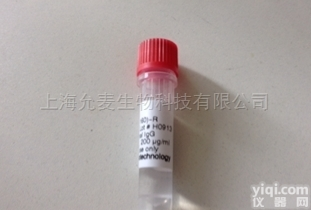供应商:上海经科化学科技有限公司
服务热线:400-0199-638
QQ:472482400(上海经科)
微信号:shjkchem
活动:消费积分可换充值卡!
兔抗拟南芥致病相关蛋白1(PR-1)多克隆抗体介绍:
货 号:AS10 687
中文名称:兔抗拟南芥致病相关蛋白1(PR-1)多克隆抗体
英文名称:PR-1|Pathogenesis-related protein 1
应用:western blot (WB)
规格:50 µl
价格:4440元
兔抗拟南芥致病相关蛋白1(PR-1)多克隆抗体简介:
| PRODUCT INFORMATION | | background | | Pathogenesis-related protein 1 (PR-1) is partially responsible for acquired pathogen resistance. Induced by INA, salicylic acid and pathogen infection. | | immunogen | | recombinant part of PR-1 protein from Arabidopsis thaliana UniProt: P33154, TAIR: At2g14610 | | host | | rabbit | | clonality | | polyclonal | | purity | | serum | | format | | lyophilized | | quantity | | 50 µl | | reconstitution | | For reconstitution add 50 µl of sterile water. | | storage | | store lyophilized/reconstituted at -20°C; once reconstituted make aliquots to avoid repeated freeze-thaw cycles. Please, remember to spin tubes briefly prior to opening them to avoid any losses that might occur from lyophilized material adhering to the cap or sides of the tubes. | | tested applications | | western blot (WB) | | related products | | AS10 687S PR-1 protein standard, for quantification and postive control
AS12 2366 PR-2 pathogenesis-related protein 2, rabbit antibodies for Arabidopsis thaliana
AS07 208 PR-2 GLU I class I beta-1,3-glucanase, rabbit antibodies for other species, notArabidopsis thaliana AS07 207 PR-3 CHN class I chitinase, rabbit antibodies
AS12 2369 PR-4 Pathogenesis-related protein 4, rabbit antibodies
AS12 2373 PR-5 Pathogenesis-related protein 5, rabbit antibodies collection of antibodies to other proteins involved in a response to pathogen attack | | additional information | | PR-1 protein is present in very low amonts in non-induced plant material.
Overnight antibody incubation is not recommended. | |
| APPLICATION INFORMATION |
| recommended dilution | | 1: 2500 (WB) |
| expected | apparent MW | | 17.7 kDa (Arabidopsis thaliana) |
| confirmed reactivity | | Arabidopsis thaliana, Hordeum vulgare, Zea mays, Spinacia oleracea, Solanum lycopersicum, Triticum aestivum |
| predicted reactivity | | Brassica rapa subsp. pekinensis, Brassica napus, Eutrema japonica, Glycine max, Solanum tuberosum |
| not reactive in | | no confirmed exceptions from predicted reactivity are currently known |
| additional information | | Re-using of antibody solution is not recommended. It will contribute to incrteased background signal. |
| selected references | | not available at the moment, antibody release in November 2013. |
Application example
western blot -1

Recombinant PR-1 protein (0.2 pmol) (7) and 20 µg of a total protein from Arabidopsis thaliana (1), Hordeum vulgare (2), Zea mays (3),Spinacia oleracea (4), Solanum esculentum (5), Triticum aestivum (6) were extracted with Protein Extraction Buffer PEB (AS08 300), recombinant PR-1 (7) and were supplemented with 50 mM DTT and heat at 70°C for 5 min and kept on ice before loading. Protein separation was done using NuPage 4-12% Tris-Bis gel (Invitrogen) LDS-PAGE and blotted 1h to PVDF. Blots were blocked immediately following transfer in 2-2.5 % RPN2125 (GE Healthcare) in 20 mM Tris, 137 mM sodium chloride pH 7.6 with 0.1% (v/v) Tween-20 (TBS-T) for 1h at room temperature with agitation. Blots were incubated in the primary antibody at a dilution of 1: 2 500 in blocking reagent for 1h at room temperature with agitation. The antibody solution was decanted and the blot was rinsed briefly twice, then washed once for 15 min and 3 times for 5 min in TBS-T at room temperature with agitation. Blots were incubated in secondary antibody (anti-rabbit IgG horse radish peroxidase conjugated, recommended secondary antibody AS09 602) diluted to 1:15 000 in TBS-T for 1h at room temperature with agitation. The blots were washed as above and developed for 5 min with TMA-6 (Lumigen) detection reagent according the manufacturers instructions. Images of the blots were obtained using a CCD imager (FluorSMax, Bio-Rad) and Quantity One software (Bio-Rad). Exposure time was 1 minute.
western blot -2

10 µg of total protein from Arabidopsis thaliana columbia strain from various experimental set ups, extracted with Sigma Aldrich Plant Total Extraction Kit were separated on 15 % SDS-PAGE and blotted 1h to PVDF. Blots were blocked with for 1h at room temperature (RT) with agitation. Blot was incubated in the primary antibody at a dilution of 1: 500 for 1h at RT with agitation. The antibody solution was decanted and the blot was rinsed briefly twice, then washed once for 15 min and 3 times for 5 min in TBS-T 0.1% at RT with agitation. Blot was incubated in secondary antibody (anti-rabbit IgG horse radish peroxidase conjugated, from BioRad) diluted to 1:3 000 in for 1h at RT with agitation. The blot was washed as above and developed for 5 min with Biorad Opti-4Cn Substrate kit according to the manufacturer's instructions.
immunolocalization
| Immunostaining of Arabidopsis thaliana seedlings treated with 250 µM SA for 120 minutes for induction of PR- gene expression (right panel) or control without SA (left panel). Steps involved: fixation: in 2 % formaldehyde in MTSB buffer for 30 minutes at 37 °C; washing with water, hydrophilization with methanol; cell wall digestion: 5-7 minutes, 0.25% Dricelaze, 0.1 % Macerozyme in 5 mM MES buffer, pH5.2; cell wall permeabilization: 10 % DMSO/3 % NP40 in MTSB buffer; primary antibody incubation: dilution 1: 200 in MTBS buffer for 3 h at RT; secondary antibody incubation: dilution 1: 1000 at RT for 1 h, goat-anti rabbit IgG Alexa 488 conjugated antibody. |
 兔抗拟南芥致病相关蛋白1(PR-1)多克隆抗体
兔抗拟南芥致病相关蛋白1(PR-1)多克隆抗体
 EPEC/E.coli(enteropathogenic E.coli,EPEC) 普通大肠埃希菌菌体蛋白(非致病性)抗体厂家供应
EPEC/E.coli(enteropathogenic E.coli,EPEC) 普通大肠埃希菌菌体蛋白(非致病性)抗体厂家供应
 普通大肠埃希菌菌体蛋白(非致病性)抗体厂家
普通大肠埃希菌菌体蛋白(非致病性)抗体厂家
 拟南芥表达谱芯片,拟南芥基因芯片,拟南芥基因组芯片,拟南芥基因表达芯片,拟南芥芯片 Arabidopsis Gene Expression Microarray
拟南芥表达谱芯片,拟南芥基因芯片,拟南芥基因组芯片,拟南芥基因表达芯片,拟南芥芯片 Arabidopsis Gene Expression Microarray
 拟南芥ACA11 / 拟南芥ACA11抗体
拟南芥ACA11 / 拟南芥ACA11抗体
 拟南芥IKI3 / 拟南芥IKI3抗体
拟南芥IKI3 / 拟南芥IKI3抗体
 拟南芥ACA11 / 拟南芥ACA11抗体
拟南芥ACA11 / 拟南芥ACA11抗体
 拟南芥IKI3 / 拟南芥IKI3抗体
拟南芥IKI3 / 拟南芥IKI3抗体
 AHA3抗体(拟南 / AHA3抗体(拟南芥)
AHA3抗体(拟南 / AHA3抗体(拟南芥)
 AHA3抗体(拟南 / AHA3抗体(拟南芥)
AHA3抗体(拟南 / AHA3抗体(拟南芥)
 Anti-AHA3抗体 Anti-AHA3抗体,AHA3抗体(拟南芥)
Anti-AHA3抗体 Anti-AHA3抗体,AHA3抗体(拟南芥)
 Anti-ACA11抗体 Anti-ACA11抗体,拟南芥ACA11抗体
Anti-ACA11抗体 Anti-ACA11抗体,拟南芥ACA11抗体